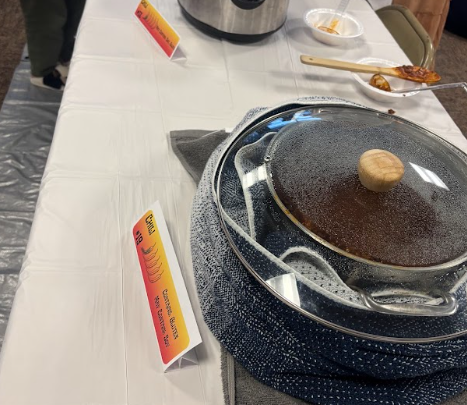With its bold flavors, rich history and countless regional variations, chili has cemented itself as more than just a meal—it is a cultural phenomenon. Beyond its historical significance, chili’s versatility allows it to be tailored to any palate, whether one seeks an inferno of heat or a mild, savory stew. As a staple of comfort food and culinary experimentation, chili continues to evolve, proving that a single dish can hold centuries of tradition and endless possibilities.
On Feb. 23 at 6 p.m., Magers Hall and Meyland Hall hosted their annual chili cook-off in the Magers lobby. Students were required to sign a contract confirming any allergies, which made them responsible for choosing what they could and could not eat before participating in the event.
Participants then grabbed a tin plate and judging card, walking around to select six chilis to try. Students judged the chilis based on taste, creativity, texture and more.
“This is a fun way to fundraise for the food pantry, and it’s mostly student-led, with some help from the RAs and RDs,” said student worker Cece McKainey.
The annual cook-off raises money for the NMU food pantry, with local businesses showing their support by participating.
“I think it’s really cool that all of the members of the community come together to help feed us really yummy chili,” said student Rahne Olson.
To accommodate the large number of students and staff attending the event, numerous varieties of chili were served, hoping to satisfy all who wished to participate.
The different types of chili chosen were chicken, pork, steak and beef, as well as vegan and vegetarian options. Not only was there a range in the contents of the chili, but also a variety of spice levels, ranging from mild to hot.
One thing about chili is that each serving can always be unique in its own way. Whether it’s an old family recipe that has been passed down for years or a new recipe being tweaked to perfection, there is always a way to make it stand out from the rest. Some people add a secret ingredient, like a dash of vanilla, while others may use plant-based meat.
Therefore, chili is far more than just a meal—it is a symbol of tradition, innovation and cultural fusion. Whether served in a competitive cook-off, enjoyed as a comforting homemade dish or debated over in terms of authenticity, chili remains a dynamic and beloved part of culinary history.
If you are looking to get more involved or are interested in more events like this one, be sure to keep an eye on the Hub or check out the posters on the bulletin boards around campus.







